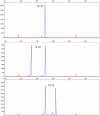CAG repeat variants in the POLG1 gene encoding mtDNA polymerase-gamma and risk of breast cancer in African-American women
- PMID: 22276120
- PMCID: PMC3262786
- DOI: 10.1371/journal.pone.0029548
CAG repeat variants in the POLG1 gene encoding mtDNA polymerase-gamma and risk of breast cancer in African-American women
Abstract
The DNA polymerase-gamma (POLG) gene, which encodes the catalytic subunit of enzyme responsible for directing mitochondrial DNA replication in humans, contains a polyglutamine tract encoded by CAG repeats of varying length. The length of the CAG repeat has been associated with the risk of testicular cancer, and other genomic variants that impact mitochondrial function have been linked to breast cancer risk in African-American (AA) women. We evaluated the potential role of germline POLG-CAG repeat variants in breast cancer risk in a sample of AA women (100 cases and 100 age-matched controls) who participated in the Women's Circle of Health Study, an ongoing multi-institutional, case-control study of breast cancer. Genotyping was done by fragment analysis in a blinded manner. Results from this small study suggest the possibility of an increased risk of breast cancer in women with minor CAG repeat variants of POLG, but no statistically significant differences in CAG repeat length were observed between cases and controls (multivariate-adjusted odds ratio 1.74; 95% CI, 0.49-6.21). Our study suggests that POLG-CAG repeat length is a potential risk factor for breast cancer that needs to be explored in larger population-based studies.
Conflict of interest statement
Figures
References
-
- Amend K, Hicks D, Ambrosone CB. Breast cancer in African-American women: differences in tumor biology from European-American women. Cancer Res. 2006;66:8327–8330. - PubMed
-
- Carey LA, Perou CM, Livasy CA, Dressler LG, Cowan D, et al. Race, breast cancer subtypes, and survival in the Carolina Breast Cancer Study. JAMA. 2006;295:2492–2502. - PubMed
-
- Walsh T, King MC. Ten genes for inherited breast cancer. Cancer Cell. 2007;11:103–105. - PubMed
-
- Yu M, Zhou Y, Shi Y, Ning L, Yang Y, et al. Reduced mitochondrial DNA copy number is correlated with tumor progression and prognosis in Chinese breast cancer patients. IUBMB Life. 2007;59:450–457. - PubMed
Publication types
MeSH terms
Substances
Grants and funding
LinkOut - more resources
Full Text Sources
Medical


